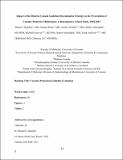Files in this item
Impact of the Diabetes Canada Guideline Dissemination Strategy on the prescription of vascular protective medications : a retrospective cohort study, 2010-2015
Item metadata
| dc.contributor.author | Rigobon, Alanna V | |
| dc.contributor.author | Kalia, Sumeet | |
| dc.contributor.author | Nichols, Jennica | |
| dc.contributor.author | Aliarzadeh, Babak | |
| dc.contributor.author | Greiver, Michelle | |
| dc.contributor.author | Moineddin, Rahim | |
| dc.contributor.author | Sullivan, Frank | |
| dc.contributor.author | Yu, Catherine | |
| dc.date.accessioned | 2018-11-15T11:30:07Z | |
| dc.date.available | 2018-11-15T11:30:07Z | |
| dc.date.issued | 2019-01 | |
| dc.identifier | 256486116 | |
| dc.identifier | af648522-f93a-41ab-b79d-4f364c33d498 | |
| dc.identifier | 30389671 | |
| dc.identifier | 85059077082 | |
| dc.identifier | 000453904900031 | |
| dc.identifier.citation | Rigobon , A V , Kalia , S , Nichols , J , Aliarzadeh , B , Greiver , M , Moineddin , R , Sullivan , F & Yu , C 2019 , ' Impact of the Diabetes Canada Guideline Dissemination Strategy on the prescription of vascular protective medications : a retrospective cohort study, 2010-2015 ' , Diabetes Care , vol. 42 , no. 1 , pp. 148-156 . https://doi.org/10.2337/dc18-0935 | en |
| dc.identifier.issn | 0149-5992 | |
| dc.identifier.other | ORCID: /0000-0002-6623-4964/work/50460143 | |
| dc.identifier.uri | https://hdl.handle.net/10023/16473 | |
| dc.description | Funding: Diabetes Canada | en |
| dc.description.abstract | OBJECTIVE: The 2013 Diabetes Canada guidelines launched targeted dissemination tools and a simple assessment for vascular protection. We aimed to 1) examine changes associated with the launch of the 2013 guidelines and additional dissemination efforts in the rates of vascular protective medications prescribed in primary care for older patients with diabetes and 2) examine differences in the rates of prescriptions of vascular protective medications by patient and provider characteristics. RESEARCH DESIGN AND METHODS: The study population included patients (≥40 years of age) from the Canadian Primary Care Sentinel Surveillance Network with type 2 diabetes and at least one clinic visit from April 2010 to December 2015. An interrupted time series analysis was used to assess the proportion of eligible patients prescribed a statin, ACE inhibitor (ACEI)/angiotensin receptor blocker (ARB), or antiplatelet prescription in each quarter. Proton pump inhibitor (PPI) prescriptions were the reference control. RESULTS: A dynamic cohort was used where participants were enrolled each quarter using a prespecified set of conditions (range 25,985-70,693 per quarter). There were no significant changes in statin (P = 0.43), ACEI/ARB (P = 0.42), antiplatelet (P = 0.39), or PPI (P = 0.16) prescriptions at baseline (guideline intervention). After guideline publication, there was a significant change in slope for statin (-0.52% per quarter, SE 0.15, P < 0.05), ACEI/ARB (-0.38% per quarter, SE 0.13, P < 0.05) and reference PPI (-0.18% per quarter, SE 0.05, P < 0.05) prescriptions. CONCLUSIONS: There was a decrease in prescribing trends over time that was not specific to vascular protective medications. More effective knowledge translation strategies are needed to improve vascular protection in diabetes in order for patients to receive the most effective interventions. | |
| dc.format.extent | 802771 | |
| dc.language.iso | eng | |
| dc.relation.ispartof | Diabetes Care | en |
| dc.subject | RA0421 Public health. Hygiene. Preventive Medicine | en |
| dc.subject | RC Internal medicine | en |
| dc.subject | NDAS | en |
| dc.subject | SDG 3 - Good Health and Well-being | en |
| dc.subject.lcc | RA0421 | en |
| dc.subject.lcc | RC | en |
| dc.title | Impact of the Diabetes Canada Guideline Dissemination Strategy on the prescription of vascular protective medications : a retrospective cohort study, 2010-2015 | en |
| dc.type | Journal article | en |
| dc.contributor.institution | University of St Andrews. Population and Behavioural Science Division | en |
| dc.contributor.institution | University of St Andrews. School of Medicine | en |
| dc.identifier.doi | https://doi.org/10.2337/dc18-0935 | |
| dc.description.status | Peer reviewed | en |
This item appears in the following Collection(s)
Items in the St Andrews Research Repository are protected by copyright, with all rights reserved, unless otherwise indicated.

